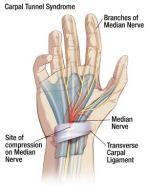- Home
- Carpal tunnel causes
- Square Wrist Sign
Square wrist sign
for carpal tunnel
The square wrist sign "test" is a great little test that can be done to see if you are at risk for getting carpal tunnel syndrome (CTS).
It is pain-free and there's no expensive equipment to use unlike the
EMG NCS tests.
Your doctor or healthcare provider uses callipers to measure your wrist. You may have heard of callipers before, they are sometimes used when you measure how much fat you have under your arms or on your hips. The measurer, pinches the skin and fat up and then the callipers are used to measure how wide the pinch is!
The same type of callipers can be used to see if you have a square type wrist or not. Some researcher discovered that if you have more of a square-shaped wrist versus a more rectangled wrist, that you are at more of a risk for getting CTS.
Having a squared-shaped wrist is a major predisposing factor for CTS according to Dr. Kuhlman (from a study published in American Journal of Physical Medicine).
The "TEST" is positive (indicating you have the condition) if the ratio of the thickness of the wrist (from top to bottom of wrist) DIVIDED by the WIDTH of the wrist (from side to side)... is GREATER THAN 0.7
It sounds more complicated than it is. So lets use one of my patients as an example. His wrist is 4.5cm thick and it is 6cm wide (note, that the measurement should be taken at the wrist crease closet to the palm) Now enter into your calculator 4.5 and divide it by 6, and you should come up with 0.75, which is greater than 0.7,so he is at a greater risk for getting CTS, and as it works out, he does have a case of moderate CTS.
Now obviously the
SQUARE WRIST SIGN is not always going to be 100% accurate, just like all the other carpal tunnel tests we've talked about.
But this test can be a CHEAP, QUICK AND EASY little screening tool that your doctor can use. You may want to pick up a cheap pair of callipers at a store that sells science or school supplies to test on yourself!
Remember though that other factors like we discussed in CARPAL TUNNEL SYNDROME CAUSES can also play an important role in who gets CTS.
Anatomy of the carpal tunnel
CTS Explanation
How CTS is diagnosed
Non-surgical treatments
CTS wrist braces
- Home
- Carpal tunnel causes
- Square Wrist Sign
Share this page:
Recent Articles
-
The carpal tunnel store
The carpal tunnel store has a huge selection of Medical Grade Products -
Anatomy of the carpal tunnel
The carpal tunnel anatomy is easy to understand if you remember we're dealing with a tunnel of sorts in your wrist. Learn the anatomy from a medical practitioner. -
Carpal tunnel prevention program
A carpal tunnel prevention program at the workplace may help employees from getting symptoms. Learn the best carpal tunnel prevention program on the web today.
Recent Articles
-
The carpal tunnel store
The carpal tunnel store has a huge selection of Medical Grade Products -
Anatomy of the carpal tunnel
The carpal tunnel anatomy is easy to understand if you remember we're dealing with a tunnel of sorts in your wrist. Learn the anatomy from a medical practitioner. -
Carpal tunnel prevention program
A carpal tunnel prevention program at the workplace may help employees from getting symptoms. Learn the best carpal tunnel prevention program on the web today.
